SOIL STABILIZATION USING WASTE FIBER MATERIAL
1Asst. Prof. in Geotechnical Engineering, Dept. of Civil Engineering, Synergy Institute of Technology, Odisha, India.

2Asst. Prof. in Structural Engineering, Dept. of Civil Engineering, Synergy Institute of Technology, Odisha, India.
3Prof. in Structural Engineering, Dept. of Civil Engineering, Synergy Institute of Technology, Odisha, India. ***
ABSTRACT
Soil is very important part in every construction work. But some types of soil could not bear the load, so we need to improve its properties. Structure which have constructed over the expansive soil may occurred several damage due to high swelling behavior. So these types of soil need to be stabilized by increase its shear strength, load bearing capacity and durability as well as to prevent from erosion. The new technique can be effectively used for soil stabilization by using waste materials. Various case studies have been carried out for these types of soil to increases its soil properties. The main objective of this study is to investigate the use of waste fiber material in geotechnical application and to evaluate the effect of waste polypropylene fibers on shear strength of soil by adding different percentage on the shear strength test of different types of soil samples. The laboratory tests were conducted like Specific gravity, Liquid limit, Plastic limit, Sieve analysis, Standard proctor test, direct shear and UCS test discriminative fiber contents. This aims of the project work to evaluate the effect of the addition of 0%, 0.05%, 0.15%, 0.25% reinforcement to stabilize the soil.
Keywords: Polypropylene fibers, Standard Proctor, UCS, Atterberg Limits, Specific gravity, Direct shear test
1. INTRODUCTION
Soil stabilization is the process in which we meliorate the physical parcels of soil by adding external agents. Soils are generally stabilized to increase their strength and continuity or to help corrosion and dust conformation in soils. The main end is the creation of a soil material or system that will hold under the design use conditions and for the designed life of the engineering design. The parcels of soil vary a great deal atdifferentplacesorincertaincasesindeedatoneplace; the success of soil stabilization depends on soil testing. colorful styles are employed to stabilize soil and the system should be vindicated in the lab with the soil material before applying it on the field. For any structure, the most important part of the structure is a foundation,whichstronglycarriedouttheentireweight of the structure. In order for foundation, soil plays the most important part in it. So work with soil, first of all,
wehavetohaveproperknowledgeaboutitsparcelsand the factors which affect the behavior of the soil. The processesofsoilstabilizationenhancetheparcelsofsoil and achieve the demanded need for the construction work. In recent times, the demand for structure, raw accouterments, and energy has increased, so soil stabilization has started to take a new shape. In India, theultramodern periodofsoilstabilization beganinthe early 1970s, with a general insufficiency of petroleum andsummations,itcamenecessaryforthemasterminds to look at means to ameliorate soil other than replacing thepoorsoilatthestructurepoint.Inrecenttimes,with the increase in the demand for structure, raw paraphernalia, and energy, soil stabilization has started to take a new shape. With the vacuity of better exploration, paraphernalia, and outfit, it's arising as a popular and cost-effective system for soil enhancement. The enhancement in the shear strength parameters has beenstressedandrelativestudieshavebeencarriedout usingdifferentstylesofshearresistancedimension.
1.1 OBJECTIVE OF THE STUDY
Toevaluatetheindexpropertiesofdifferentsoil samples.
By using polypropylene fiber, the strength characteristicsofthesoilincreases.
Compare the strength properties between different soil samples with fiber and without fiber.
The soil strength was increases by adding differentpercentageofpolypropylenefiber.
Observed the effect of fiber on the shear strength value and compressive strength of the soil.
2. MATERIALS USED
2.1 SOIL
The soil is collected from Near Phulnakhara and Naraj Cuttack. Differenttypesoflaboratory propertiessuchas specific gravity, Atterberg limits, Standard proctor test, Direct shear test and UCS test. The physical characteristics of soil are summarized in Table-1 and Table-2.
Polypropylene fiber (PPF) is light weight, high strength, andcorrosionresistancepolymermaterial Itisusedasa agentinsoilstabilization
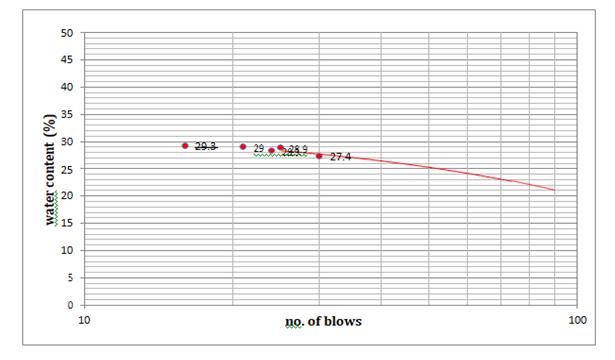




The above figure shows the liquid limit of two different types of soil. The liquid limit of soil sample 1 and 2 was 28.29%and43.49%respectively.



The above figure shows the OMC and MDD of different soil samples. The OMC and MDD of soil sample-1 was 12.60% and 1.91gm/cc respectively. The OMC and MDD of soil sample-2 was 17.02% and 1.96gm/cc respectively.


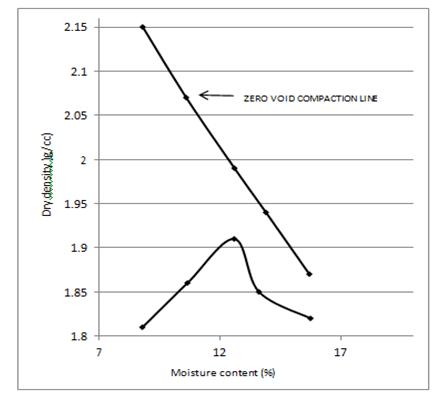

The above figure shows shear strength of soil sample-1 without and with reinforcement. The value of Cohesion of soil sample-1 with 0%, 0.05%, 0.15% and 0.25% of reinforcement was 0.325kg/cm2, 0.357kg/cm2 , 0.374kg/cm2 and0.388kg/cm2 respectively.Thevalueof angel of internal friction of soil sample-1 with 0%, 0.05%, 0.15% and 0.25% of reinforcement was 47.720 , 48.100,48.250 and48.480
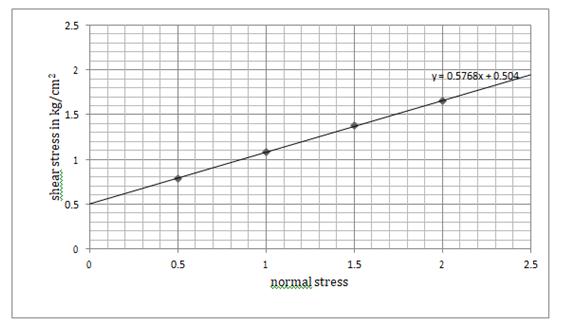
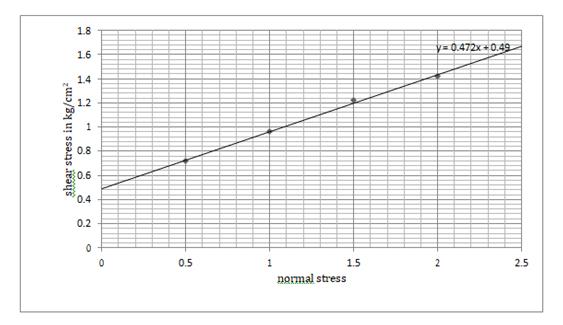
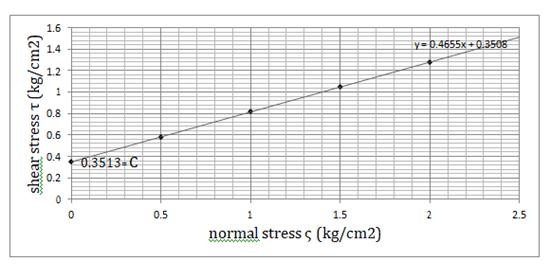
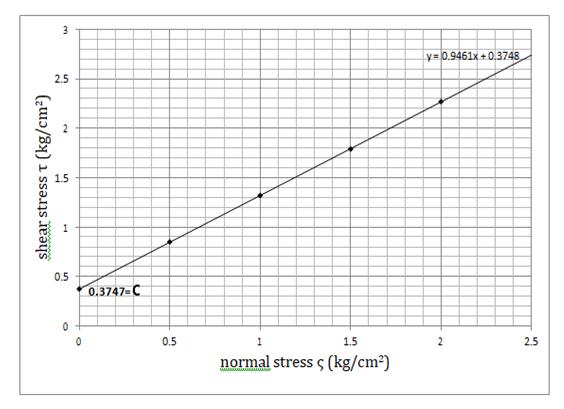
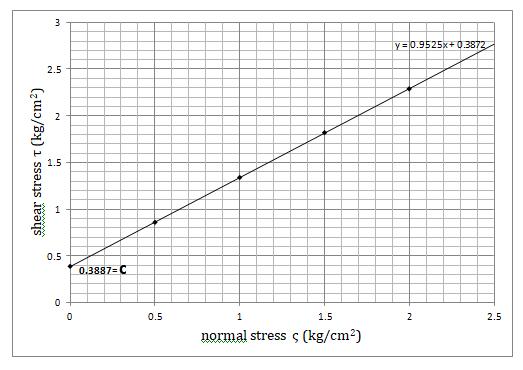



The above figure shows shear strength of soil sample-1 without and with reinforcement. The value of Cohesion of soil sample-2 with 0%, 0.05%, 0.15% and 0.25% of reinforcement was 0.351kg/cm2, 0.473kg/cm2 , 0.504kg/cm2 and0.537kg/cm2 respectively.Thevalueof angel of internal friction of soil sample-1 with 0%, 0.05%, 0.15% and 0.25% of reinforcement was 27.820 , 29.020,29.950 and320 .




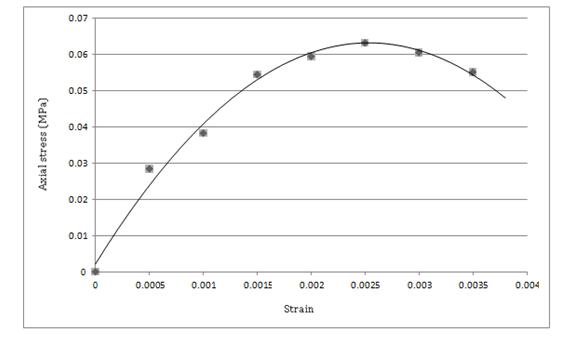
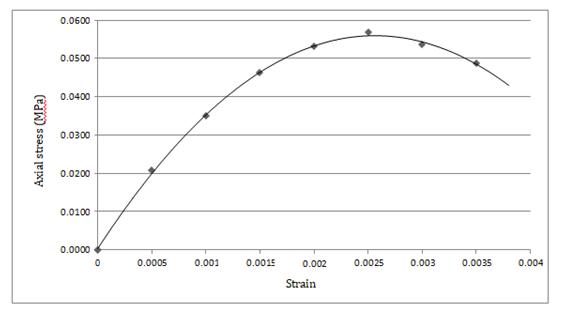
3.5 UNCONFINED COMPRESSIVE STRENGTH TEST
The above figure shows compressive strength of soil sample-1 without and with reinforcement. The value of Cohesion of soil sample-1 with 0%, 0.05%, 0.15% and 0.25% of reinforcement was 0.056MPa, 0.0631MPa, 0.0637MPaand0.064MPa.

The above figure shows compressive strength of soil sample-1 without and with reinforcement. The value of Cohesion of soil sample-1 with 0%, 0.05%, 0.15% and 0.25% of reinforcement was 0.069MPa, 0.093MPa, 0.096MPaand0.103MPa.

4. CONCLUSION
Grounded on direct shear test on soil sample- 1, with fiber underpinning of0.05,0.15 and0.25, the increase in cohesionwassetuptobe10,4.8and3.73independently. Theincreaseintheinternalangleofdisunion(φ)wasset up to be0.8,0.31 and 0. 47 independently. Since the net increase in the values of c and φ were observed to be19.6, from0.325 kg/ cm2 to0.3887 kg/ cm2 and1.59, from47.72 to48.483 degrees independently, for such a soil, aimlessly distributed polypropylene fiber underpinning isn't recommended. The results from the UCStestforsoilsample-1arealsoanalogous,formounts of0.05,0.15 and0.25, the increase in unrestrained compressive strength from the original value are 11.68,1.26 and0.62 independently. This proliferation
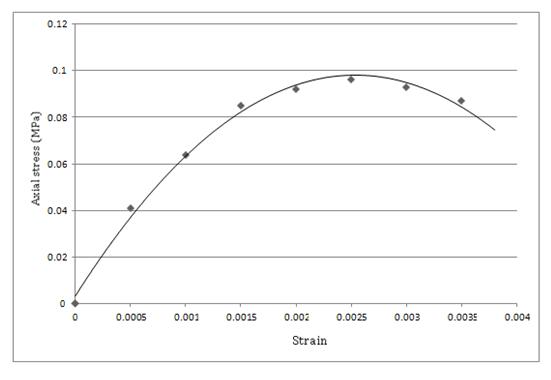
isn't substantial and applying it for soils analogous to soil sample- 1 isn't effective. The shear strength of soil sample- 2 the increase in the value of cohesion for fiber underpinning of0.05,0.15 and0.25 are34.7,6.09 and7.07 independently. Figure 27 illustrates that the increase in the internal angle of disunion( φ) was set up to be0.8,0.31 and 0. 47 independently. therefore, a net increaseinthevaluesofcandφwereobservedtobe53, from0.3513 kg/ cm2 to0.5375 kg/ cm2 and15.02 from27.82 to32 degrees.thus,the use of polypropylene fiber as underpinning for soils like soil sample- 2 is recommended. On comparing the results from UCS test of soil sample- 2, it's set up that the values of unrestrained compressive strength shows a net proliferation of49.8 from0.0692 MPa to 0.1037 MPa. This also supports the former conclusion that use of polypropylene filaments for buttressing soils like soil sample- 2 is recommended. Overall it can be concluded thatfibercorroboratedsoilcanbeconsideredtobegood ground enhancement fashion especially in engineering systems on weak soils where it can act as a cover to deep/ raft foundations, reducing the cost as well as energy.
REFERENCE
1. S.A. Naeini and S. M. Sadjadi,(2008) ,” Effect of Waste Polymer Materials on Shear Strength of Unsaturated Clays”, EJGE Journal, Vol 13, Bund k,(1-12).
2. Yetimoglu, T., Inanir, M., Inanir, O.E., 2005. A study on bearing capacity of randomly distributed fiber-reinforced sand fills overlying softclay.GeotextilesandGeomembranes23(2), 174–183.
3. Chaosheng Tang, Bin Shi, Wei Gao, Fengjun Chen, Yi Cai, 2006. Strength and mechanical behaviorofshortpolypropylenefiberreinforced and cement stabilized clayey soil. Geotextiles andGeomembranes25(2007)194–202.
4. Mahmood R. Abdi, Ali Parsapajouh, and Mohammad A. Arjomand,(2008),” Effects of Random Fiber Inclusion on Consolidation, Hydraulic Conductivity, Swelling, Shrinkage Limit and Desiccation Cracking of Clays”, InternationalJournalofCivilEngineering,Vol.6, No.4,(284-292).

5. Consoli, N. C., Prietto, P. D. M. and Ulbrich, L. A. (1999). ‘‘The behavior of a fibre- reinforced cemented soil.’’ Ground Improvement, London, 3(1),21–30.
6. Prof. Krishna Reddy, UIC,2008, Engineering PropertiesofSoilsBasedonLABtest.
7. Punmia B.C. 2007, “Soil Mechanics & Foundations”LaxmiPublications.
8. Yadav Parit, Meena Kuldeep Kumar, (2011)” A comparative study in soil plasticity of Hall area and lecture complex area of NIT Rourkela” B.techthesis,NIT,Rourkela.
9. IS:2720(Part2),1973MethodsofTestforSoils, Determinationofwatercontent.
10. IS 2720(III/SEC-I): 1980 Methods of Test for Soils,Determinationofspecificgravity.
11. IS 2720(VII):1980 Methods of Test for Soils, Determination of water content dry density relationusinglightcompaction.

12. IS 2720(XIII):1986 Methods of Test for Soils, directsheartest
13. IS 2720(X):1991 Methods of Test for Soils, determinationofunconfinedcompressiontest.
14. IS 2720(IV):1985 Methods of Test for Soils, determinationofgrainsizeanalysis.
